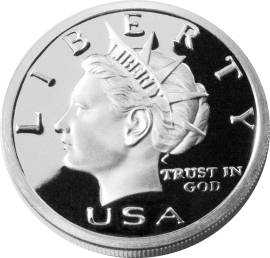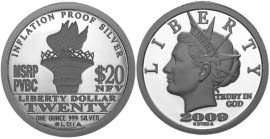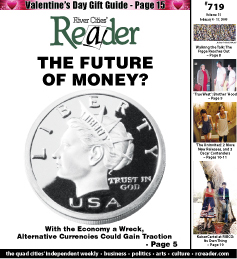In Fairfield, Iowa, those same coins are accepted at more than 15 merchants, from Mexican restaurants to Radio Shack.
They're called Liberty Dollars, and they're part of a movement called "community currencies," or "alternative" or "competing" and "complementary" currencies. And with the economy seemingly getting worse each day, you're likely to hear a lot more about them.
Different Concerns, Different Conceptions
Most people accept the Federal Reserve Note as the United States' currency, and we conduct almost all of our transactions in that currency.
But several factors are driving people to seek alternatives.
On the one hand, the Federal Reserve monetary policy has devalued the currency. In 2008, the dollar had only 38 percent of the purchasing power it had in 1980, and last year it was worth less than 4 percent of its 1900 value.
"The U.S. dollar could be a good currency if you had tight central control," said Dan Priest, CEO of the company that produces Liberty Dollars. "The trouble is that it is so tempting to run the printing press that politicians always give in."
On the other hand is the global and corporate economic culture that excludes many people, and sucks resources out of communities.
From those two very different concerns have sprung two very different conceptions of alternative currencies, one generally conservative and the other more liberal. "There's an incredible spark in interest right now" in alternative currencies, Priest said.
On the conservative side are people concerned about how U.S. monetary policy - specifically the decoupling of the dollar from the value of precious metals - has led to the devaluation of currency. They point out United States legal tender is inherently worthless and have developed coins and bills backed by silver and gold. "It's just green paper with ink," Priest said of Federal Reserve Notes.
On the liberal side are people who believe the dollar-based economy excludes people with valuable skills, and who believe that the money generated by that economy doesn't stay in the community.
"These [alternative-currency systems] enable businesses and individuals that otherwise could not participate in the regular U.S. dollar economy to gain a medium of exchange - a local currency that they can use," said Lewis D. Solomon, professor of law at the George Washington University Law School and author of the 1996 book Rethinking Our Centralized Monetary System.
Just as important, Solomon said, the money stays in the community. "It's a way to help a region, a locality where the currency circulates," he said. "Local currency is one of the few ways you can build a local or regional economy," because by its nature as a community currency, it's not likely to be accepted outside that community.
Something of Value, No Matter What
 The Liberty Dollar is just one of many commodity-backed currencies.
The Liberty Dollar is just one of many commodity-backed currencies.
The reason these currencies are becoming more popular is that they're "inflation-proof," as the Liberty Dollar marketing claims. While the Federal Reserve can print more money - thus reducing the value of every dollar in existence - gold, silver, and other precious metals have an inherent value because of their scarcity.
"Since it's based on a commodity - gold and silver - it actually keeps wealth local," Priest said. "It keeps wealth in the device [the coin] itself. ... You know that you have something of value, no matter what."
In other words, if the United States has a currency crisis and the exchange value of Federal Reserve Notes drops (in terms of purchasing power or in relation to other currencies), a Liberty Dollar coin will still have its value.
Priest emphasized that it's not about hoarding wealth; the key is circulation. "We believe that money does have value, and that it should be backed by value," he said. "But then we also believe that it's a currency and should circulate. ... We believe that the more circulation you get for something like silver, the more the wealth and resources actually stay in the community."
While Liberty Dollars are accepted at merchants from coast to coast, it still acts as a community currency, because an activist or group of activists introduces it to local merchants and promotes its use. That's what happened in Chambersburg, Pennsylvania, and Fairfield, Iowa.
The Liberty Dollar was launched in 1998 and now has 2 million ounces of silver in circulation. Based on the current $20 "nominal face value" of a one-ounce coin, that's the equivalent of $40 million.
"It's actually worth whatever you can get for it," Priest said. One merchant might give you $18 worth of goods and services for the one-ounce coin, while another might give you $22.
The Liberty Dollar face value is tied to the price of silver, and with silver prices dropping (to under $13 an ounce), last month the Liberty Dollar dropped the nominal face value of its one-ounce coin to $20 from $50. So even though an older one-ounce coin lists a nominal face value of $50, right now traders are likely to get significantly less for that coin because of the drop in silver prices. But Priest said that dollar inflation over time will increase the coins' buying power.
He added that citizens ought to be able to use whatever medium of trade they want. "People have a right to decide what it is that they want to do their exchanges with," Priest said. "This is a consensual society. If you wanted eggs, and what I have is eggs, we ought to be able to do a trade."
Yet the legality of the Liberty Dollar (and other minted alternative currencies) is a matter of dispute.
In a 2006 press release (USMint.gov/pressroom/index.cfm?action=press_release&id=710), the U.S. Mint emphasized that Liberty Dollars are not legal tender: "Despite their misleading appearance, NORFED [National Organization for the Repeal of the Federal Reserve Act & the Internal Revenue Code, the corporation under which the Liberty Dollar was produced through 2006] 'Liberty Dollar' medallions are not genuine United States Mint coins, and they are not legal tender."
The release further argues that Liberty Dollars violate federal law: "Prosecutors with the United States Department of Justice have concluded that the use of NORFED's 'Liberty Dollar' medallions violates 18 U.S.C. Section 486, and is a crime." (Many conservatives argue that the cited law is unconstitutional.)
In November 2007, the FBI raided Liberty Dollar facilities, taking, according to Priest, 200,000 ounces of silver backing paper notes and digital currency. Using today's exchange base, that's the equivalent of $4 million. Those precious metals remain in federal custody, he said.
Priest insists that the Liberty Dollar is legal. "This is not [designed as] legal tender," he said. "It's a voluntary exchange."
In addition, he said, "there have been no charges, and there's been no legal cease-and-desist order. We actually think this was just a strategy to slow us down, if not put us out of business."
Your Own Backyard
 The challenge with commodity-backed currency is that it's commodity-backed; it requires the purchase of significant amounts of precious metals to start up. "It actually takes a bit of an investment," Priest said.
The challenge with commodity-backed currency is that it's commodity-backed; it requires the purchase of significant amounts of precious metals to start up. "It actually takes a bit of an investment," Priest said.
But there's very little cost in printing paper community currency, and that's what many organizations have done. "If you have a printer, you could actually have a community currency," he said.
But for a paper currency to work, it requires several prerequisites. First, there must be many people willing to accept it, because it has no intrinsic value. Second, there needs to be tight control over the supply of community currency, lest it lose the value it has.
"There are many benefits, but somebody has to run it," Solomon said. "Some person can't just do it one hour a month."
Two prominent examples of community currency are Ithaca Hours (in New York) and BerkShares (in Massachusetts), but there are dozens of others. Ithaca Hours were launched in 1991, while BerkShares were created in 2006. With BerkShares, five banks offer an exchange service - $90 in U.S. dollars buy 100 BerkShares - and the currency is accepted at approximately 350 merchants. Two million BerkShares are currently in circulation.
Tying the value of local currency to the dollar is not ideal, Solomon admitted; it puts the currency at risk of devaluation. But unless one is willing to back the currency with precious metals, using the dollar "is a sounder system than one just based on trust."
An offshoot of community currency is time-banking, in which people exchange time.
"It's mostly service exchange," said Stephanie Rearick, director and founder of the Dane County Time Bank in Madison, Wisconsin. (Madison also has a local currency.) "Individuals and organizations join and then catalog what they can do for each other. Every hour that somebody helps another time-bank member, they get a time dollar in their account. And it's really just a credit, and it's worth an hour of anybody else's time in the network. ... There's no monetary equivalent. One time dollar is worth one hour, always."
While community currency is focused on commerce, she said, time banks are better-suited to community organizing and neighborhood services. In three years of existence, the Dane County Time Bank has attracted 1,020 members who have exchanged more than 23,000 hours of service.
"You can do it without having money," Rearick said. "People can access all kinds of things they wouldn't be able to afford to access otherwise. And then it also just has a really different feeling to it. Money's scarce, and time dollars aren't scarce."
Even though they're very different, commodity-backed currencies, unbacked community currencies, and time banks are all decidedly local. Both Solomon and Priest said that people need to look for local solutions to our problems instead of relying on the federal government.
"What we see is the nation if not the world looking to the federal government to get us out of our current plight," Solomon said. "Do we want a more local or regional-based economy rather than a national or global one? That is a very important questions that is not really being asked today."
"We're under the illusion that the government will spend money, that that will actually solve all the problems," Priest said. "But government doesn't actually produce anything. Wealth comes from people producing."
"I think people are so fixated on Washington," Solomon said. "They've got to do things in their own backyard."
Resources on Alternative Currencies
Commodity-backed currencies
The American Open Currency Standard: OpenCurrency.com
Liberty Dollar: LibertyDollar.org
NORFED, the precursor to the Liberty Dollar organizaton: NORFED.org
Chambersburg, Pennsylvania, Liberty Dollar campaign: ChambersburgLibertyDollar.com
Federal affidavit about the Liberty Dollar FBI raid: JohnLocke.org/site-docs/meckdeck/pdfs/USAVLibdoll.pdf
Other alternative currencies/exchanges
Ithaca Hours: IthacaHours.org
BerkShares: BerkShares.org
Time Banks: TimeBanks.org











